The Road to Mandalay
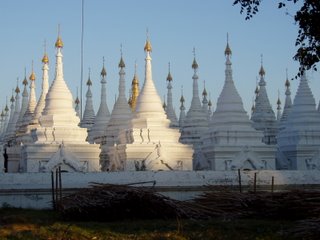 My elementary school had large roll down maps of the world. When the map wasn’t on display at the side of the room, it was rolled up on its two long poles and stored in the corner of the cloak room. The maps were old so the pink parts were still labelled as the British Empire although we had begun to refer to it as the Commonwealth. But whatever one calls it, the variety and number of nations involved is impressive. Names such as Burma and the Road to Mandalay exert an emotional tug on me still that is likely rooted in those early maps.
My elementary school had large roll down maps of the world. When the map wasn’t on display at the side of the room, it was rolled up on its two long poles and stored in the corner of the cloak room. The maps were old so the pink parts were still labelled as the British Empire although we had begun to refer to it as the Commonwealth. But whatever one calls it, the variety and number of nations involved is impressive. Names such as Burma and the Road to Mandalay exert an emotional tug on me still that is likely rooted in those early maps.Some of the names are now changed. Myanmar, it turns out, has always been the local translation for Burma. Myanmar opened up to travel a couple of year ago. My friend, Aye, who has worked in Malaysia for 20 years is taking a group of us with her to visit her home. For me, it is finally a trip on the Road to Mandalay.
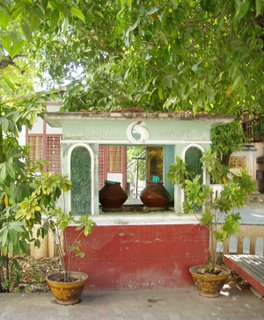
We stay in Yangoon in the family compound formed of the homes of her brothers and amazingly her own home waiting for us. We are a couple of streets from where Aun Sang Suu Kyi is held under house arrest. Depending on what is happening at Aun Sang’s place, traffic is rerouted and the street we are on becomes very busy. It makes the cruel and seemingly endless detention so much more awful to be here with her so close.
Along the roadways in town and especially in the rural areas, we notice that homeowners have placed water-filled pottery jars by the roadside for people passing by. Not all are as elaborate as the one in the picture, but all are appreciated and used by the many on foot.
Aye has brought gifts for everyone and there is much gaiety with unpacking and kids bouncing around. We are royally welcomed and fed traditional Burmese cooking. We stay only long enough to hire a van and load up supplies. The van has seen better days but the price is right and has a driver to boot. We are happy to leave the planning of the route and sights to Aye. There are a couple of old friends to see enroute and a sister to connect with in Mandalay for the visit to the Bagan plains. Then from Mandalay we will head for the Shan plateau and the famous Inle Lake with its floating villages.
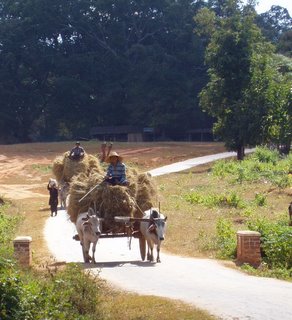
In Yangoon we practice reading Myanmarese script which, with its circular characters closely resembles Sanskrit and is sometimes referred to as “bubble script”. We are no linguists but in short order, with a little help, are reading the numbers on the license plates with ease. Heading for the post office, post cards in hand, it feels as if we have dropped back in time to when, surrounded by trees and benches, post offices where gathering places. We are advised not to expect to find post cards once we are outside of the city. But the same could be said about Sarawak and does not prepare us for the sharp contrast between Yangoon and rural Myanmar.
 Shortly after we leave Yangoon, vehicular traffic decreases dramatically. Cars and trucks are so rare, they seem out of place. Buses are non-existent. People are walking, riding bikes, driving cow-pulled racks, sitting three deep on motorbikes and coaxing donkeys, but there are few cars. That’s the first thing that hits you. That ordinary rural folk in Myanmar have limited access to motorized transport.
Shortly after we leave Yangoon, vehicular traffic decreases dramatically. Cars and trucks are so rare, they seem out of place. Buses are non-existent. People are walking, riding bikes, driving cow-pulled racks, sitting three deep on motorbikes and coaxing donkeys, but there are few cars. That’s the first thing that hits you. That ordinary rural folk in Myanmar have limited access to motorized transport. Up for an early breakfast we witness a buyer of chillis arrive in a small town. Sacks brought to town the night before on carts are lugged onto the plastic tarp the buyer has spread on the open ground. A scale is strung up under the tree. Each bag is carefully weighed and recorded before being tossed into the back of a decrepit panel truck. An hour later when the truck pulls out for the next town, it is as if it had never been there.
We set off early most days to avoid the penetrating heat of midday. After interminable tinkering by our driver, we conclude that the air conditioning works sporadically. Much time is spent working on a formula for sporadic. Everyone has their favourite theory, which like the air con, sometimes works and sometimes doesn’t. The breakfasts we find in small towns are wonderful, hot coffee and deep fried beignet-like treats. The others in the group are sticking to what they know but I am attracted to what others around us enjoying.
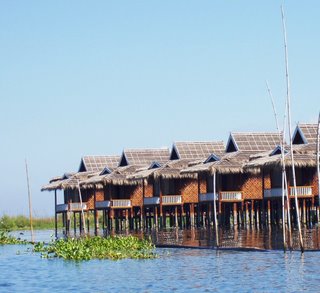
There are temples, stupas, majestic guardian lions, caves full of Buddhas and historical sites everywhere. They are well kept, clean, and visited often by the locals. On the doorstep of Mandalay we reach the Plains of Bagan, on the bank of the Ayeyarwady River. To see it for the first time is to be stunned. It is a huge area of more than 60 square miles of ornate, elaborate stupas, statues, shrines, temple painting, wall murals, monasteries and temples. Everywhere you look, there are different styles and archaeological periods on display. In the 13th century more than 4400 different structures were identified. By the early 20th century 2000 plus monuments were still standing, many of them more than 800 years old.
Bagan is one of the world’s treasures but has yet to be proclaimed so by UNESCO because that would put a stop to government plans to build fancy tourist hotels on site. Bagan was and is a deeply religious place for people in Myanmar. Legend has it that when Buddha visited as a young man he foretold there would be a golden land here where his beliefs would flourish. Burmese who can afford it still make regular pilgrimages to the area.
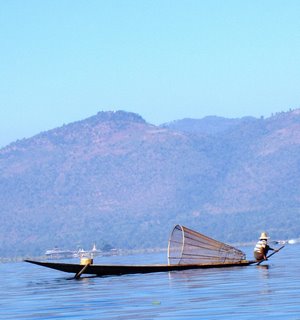
By the time we reach Mandalay, my quixotic eating habits have done me in. But the show must go on, so I lay across several seats in a huddled heap in the back of the van and spend one day in bed in Mandalay. I am back on the road in time to see Mingun Paya, which had it been finished would have been the world’s largest zedi. A zedi is a solid Buddhist monument toped by an ornate spire. Close by, carrying out the large theme, is the largest uncracked bell in the world, the Mingun Bell.
We reach our night stop high on the Shan plateau at Kalaw. It is cool and refreshing in the cabin and for the first time blankets are needed. The place brings back memories for Aye who camped here with her Girl Guide troop including Suu Kyi. We are up at 4 am for the next leg of the journey so hardly even have time to appreciate the view. The flat beds loaded with massive teak logs that come careening around corners are much more frightening at this hour in the morning mist.
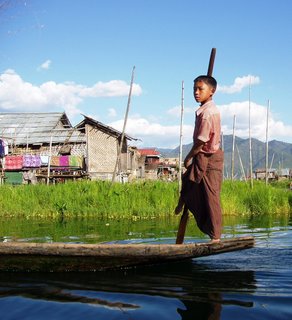 By the time we reach Inle Lake I have fully recovered. Inle Lake is surround by mountains and covered by floating islands and fishing craft. Hand poled sampans move gracefully among the islands. Some islands are floating fields where crops are tended by the farmers who ferry back and forth. Except for the lake-crossing taxis, water craft on the lake are motorless. Nets are thrown by hand in great looping swirls. Fishermen steer standing up with one leg wrapped around an oar better to steer around obstacles and watch for fish. Even small boys have mastered this fascinating technique.
By the time we reach Inle Lake I have fully recovered. Inle Lake is surround by mountains and covered by floating islands and fishing craft. Hand poled sampans move gracefully among the islands. Some islands are floating fields where crops are tended by the farmers who ferry back and forth. Except for the lake-crossing taxis, water craft on the lake are motorless. Nets are thrown by hand in great looping swirls. Fishermen steer standing up with one leg wrapped around an oar better to steer around obstacles and watch for fish. Even small boys have mastered this fascinating technique.On the other side of the lake we tour silk factories humming with the clacking of shuttles and watch women making paper from reeds and grasses and men pasting small sheets of gold leaf on a Buddha statue in an island temple.

Heading back to Yangoon, a young girl who can’t be more than 10 rides on the back of a huge water buffalo with her small brother attached on her back. I ask to stop to take pictures and an even smaller boy emerges from the bushes on another water buffalo. My friends chat with the kids and give them some oranges. It seems the kids are heading home. I am still shaking my head. We also pass tractor-pulled flats packed with children and parents on a school outing.
In Yangoon, our backsides get a chance to recover. We tour the jewelry stores where pearls, jade, coral and almost every kind of cut gem in the world can be found. Aye is an aficionado with a good eye when it comes to gems, although she doesn’t wear much jewelry herself. The others have come with specific requests so we have fun filling them and learning in the process. At night we pour over gem books.

For Burmese Buddhists the Shwedagon Paya is the most sacred site in the country, the one everyone hopes to visit at least once in their life. It is said to contain 8 hairs of the Buddha. 2500 years old and rebuilt many times, its glittering golden dome rises 98 meters into the air. Lighted up it dominates Yangoon’s night skyline. Despite its splendour, it is first and foremost a place of prayer and hums with activity all day long. I am the only tourist, all the rest in my group are Buddhists, as are most of the people in the temples we visit. Each temple visit is for them a pilgramage to be properly observed. To be there with someone making their slow round of honouring and obeisance is deeply moving.
I accompany SuuSuu, Aye’s sister-in-law. She prays at a number of spots, leaving behind jasmine, joss sticks and her prayers. After each stop she explains the site and significance to me. SuuSuu prays for her husband and a daughter at the Wednesday shrine. She tells me that is because they were born on Wednesday. She adds that there are eight such alters, one for each day but Wednesday has two, one for the morning and one for the afternoon. For some reason this arbitary, unfathomable fact cheers me. For her grandson who is going to Penang for congenital heart surgery she pauses at another site. I watch the ebb and flow of people as she makes her rounds and appreciate that this is a wonderful way to see the Shwedagon.
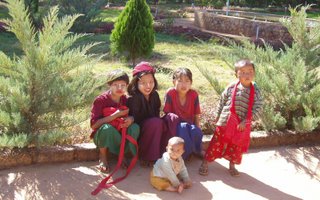
But what I appreciate most in Yangoon, even more than the intricate marionette shows and fantastic sea food at the boat hotel, is the brief afternoon visit to the Htaukkynt War Cemetery, a quiet well kept spot just outside the city. More than 20,000 graves provide the name, rank and country of origin of those who lost their lives in Burma and Assam in WW11. In the center, surrounded by the graves, is a splendid open structure of colossal marble pillars that seem to speak directly to the sky above. What a monumental structure to put in a grave yard, I think. When I get up close I read that the pillars are chiseled with the names of those who aren't buried here, but who also gave their lives here in the War to End All Wars, whole regiments of Sikhs, Karens, Gurkas, Pathans and others from all the pink places on my classroom map.
Photos: Temple spires, water by roadside, biker with baskets, animal-drawn cart, fishers on Lake Inle, boy steers boat, paper making in Inle Lake; kids on water buffalo; Shan kids
Labels: Myamar


5 Comments:
What a lovely tour! It really makes me want to visit. What is their drinking water source--underground aquafers, or surface water? Is it safe and does it taste good? And what does traditional Burmese cooking consist of? Rice/meat/fish I guess; is it spicy? (so many questions!)
Thanks for introducing me to a place I know nothing about. You are quite the world citizen! I am impressed.
What a fabulous experience you are having. And how well you describe it. Have you read "into the heart of Borneo"? Not that one can experience it more than you; but it's quite an entertaining read
Your photography and your blog are amazing! So glad I've found you.
Blogrolling you. :o)
fantastic! im planning a trip in November, great to have this report -- and to know I can turn for more advice from you later!
So nice to get comments.
TundraPA
Not sure about the source, but everywhere in the developing world it is best to boil water. Even here is Kuching we have a line of bottles that fit into the fridge and a container to hold water to cool. Burmese cooking includes lots of fish, rice and a special yellow dried pea, all of it with exquisite spices.
Sid Schwab -
TGlad you dropped by. "Into the Heart of Borneo" is a favourite. I have written about its impact on me, along with "Stranger in the Forest" by Eric Hansen in along the Rajang post.
Moof-
Welcome. Unmitigated fear has been keeping me out of the side bars but I know I need to tend to some work there.
Gawain-
I think you are close by so maybe it isn't all new to you. Lovely place and well worth a visit.
Post a Comment
<< Home